

- #Mac app for bigger previews how to
- #Mac app for bigger previews pdf
- #Mac app for bigger previews pro
- #Mac app for bigger previews free
While it’s not a full-featured image-editing app, Preview does have some remarkable capabilities that make it a good choice for working with images, especially when you consider it’s supplied free as part of the macOS.ĭestructive Editing, Auto-Save, and Versions You can use the instructions from the Mark it Up with Preview guide, linked above, to access the Markup toolbar. We’ll be using Preview’s Markup toolbar, which is usually hidden. In Part Two of the guide, we’ll look at how Preview can be used for viewing and editing images.

#Mac app for bigger previews pdf
The butterfly keyboard generation – FIVE years of defective by design – also put us off.The Preview app is a handy tool for viewing and working with PDF (Portable Document Format) files, as outlined in the Rocket Yard guide: macOS 101: Mark It Up with Preview.

We're running 3 x 2011 MBP now as they are the only ones which can be repaired and upgraded.
#Mac app for bigger previews pro
Of course we can rebuild from backups (which were a problem themselves for about six months to a year after the launch of APFS – totally unacceptable in a "pro" workflow.Īpple used to get a new MacBook Pro out of me every year or two. We just have no tools to fix them any more. And no APFS does not make all disk issues and directory structure issues go away. If you don't think not having Disk Warrior available to repair directory corruption on your startup drive is important, then either you aren't a pro or you haven't been working on Apple computers long enough.

Major disk utility companies are *still* struggling to build working versions of their disk repair utilities:
#Mac app for bigger previews how to
You can download Retroactive from GitHub and read through a wonderfully detailed guide on how to install and run Retroactive on macOS Catalina.ĪPFS might be nice, but Apple released it too early and inadequately tested (for pro use). Specifically, neither Aperture nor iPhoto are able to play videos or export slideshows, but aside from that all former functionality remains. Not all functionality is salvaged, but by and large the apps still run without much issue. If you do, it’s simply a matter of downloading Retroactive from GitHub, giving it the required permissions to alter the apps and letting it do its thing. In order to use Retroactive, you’ll need to make sure you still have a copy of Aperture or iPhoto still on your computer. The app has since been replaced with Apple’s Photos app, but whether for nostalgia purposes or something else, you can now run iPhoto. Likewise, Apple’s iPhoto app can also be modified to run in macOS Catalina with Retroactive. If you’re one of those photographers who has loyally clung to Aperture, Retroactive should ensure you can continue to use the app without having to avoid the latest macOS update. Despite this, many clung on to the last update, which worked until macOS Catalina. Tyshawn Cormier is one of those programmers who has created an app called Retroactive that modifies both Aperture and iPhoto so the apps are usable on Apple computers running macOS Catalina.Īperture was effectively neutered back in 2014 when Apple announced it was ceasing development of the pro-oriented photo management and editing application. Thankfully, there are determined developers and programmers who are always looking for the next problem to solve. While plenty more apps (including all 32-bit apps) were killed off, two photo-specific apps macOS Catalina can no longer run include Aperture and iPhoto. Apple’s new macOS Catalina operating system added plenty of new features, functionality and performance improvements, but in streamlining the experience, Apple also killed off a number of apps.


 0 kommentar(er)
0 kommentar(er)
